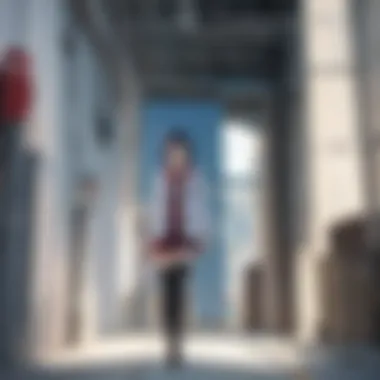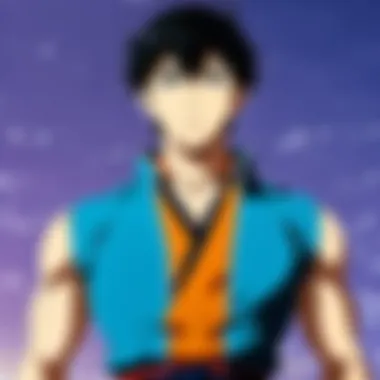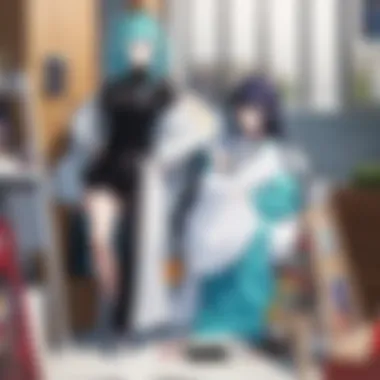An Insightful Analysis of the Best Anime Series


Prolusion to the Series
Anime, as a genre, has captivated audiences across the globe by its diverse storytelling and artistic expression. It is not just entertainment but a cultural medium reflecting societal values and experiences. In this section, we delve into the essential attributes of several notable anime series that have left a mark on viewers. Their ability to resonate with theme, character development, and visual style forms the backbone of their popularity.
The anime landscape offers a wide variety of genres, from action to romance, supernatural to science fiction. Each series brings unique elements that contribute to its standing in the vast sea of available content. Some series have achieved critical acclaim, marked by awards or high ratings on platforms such as MyAnimeList. Popular titles like Attack on Titan, Your Lie in April, and Naruto each present distinct narratives and thematic depth, appealing to different audiences.
Understanding the context of these series allows viewers to appreciate the influences that shape them. For example, Attack on Titan explores themes of freedom and oppression, paralleling real-world discussions on human rights. On the other hand, Your Lie in April focuses on themes of loss and self-discovery, with deeply moving character arcs.
In summary, the examination of the best anime series sheds light on their thematic intricacies and cultural relevance. Such insights are essential for anime enthusiasts and casual viewers alike, offering a thorough comprehension of what makes these series stand out amid the crowded landscape.
Staff and Cast Details
The success of an anime series rests significantly on the vision of its creators. The directors, writers, and animators contribute to the artistic experience that defines a series. One notable figure in this regard is Hajime Isayama, the creator of Attack on Titan, whose meticulous world-building and character development have garnered widespread acclaim.
In addition, voice actors play a vital role in bringing characters to life. The performance of Yuki Kaji, who voices Eren Yeager in Attack on Titan, is widely praised for its emotional depth. Such talent further enriches the viewing experience, allowing audiences to connect with characters on a deeper level.
Behind the scenes, the production team includes animators and sound designers who blend visual and auditory elements to create a cohesive narrative. This collaborative effort highlights the intricate nature of anime production.
Theme Music Analysis
Theme music serves as a signature element in anime, encapsulating the essence of a series. For instance, the opening theme of Your Lie in April is performed by Aimer, whose haunting voice complements the emotional themes of the story. The lyrics highlight the protagonist's struggles and his journey towards acceptance and healing, enhancing audience engagement.
The thematic relevance of such music is profound. It builds anticipation before each episode and can evoke strong emotional responses, amplifying the overall impact of the narrative. The closing songs also play a crucial role, often reinforcing the series' emotional arcs.
Plot Summary and Analysis
Diving into the plot of Attack on Titan, we find a world besieged by giant humanoid creatures, offering a blend of action and psychological depth. Key story arcs revolve around Eren Yeager's quest for freedom and what it means for humanity. This exploration intersects with themes of identity, morality, and societal structure, providing rich material for deeper analysis.
Moreover, the series employs various storytelling techniques, such as flashbacks and multiple perspectives, to enhance narrative complexity. Such choices help shape viewer perceptions and understanding of character motives and conflicts.
Reception and Impact
The reception of these anime series is often reflected in critic reviews and fan ratings. Attack on Titan enjoys high ratings on platforms like Rotten Tomatoes and MyAnimeList, establishing it as a titan in the anime community. Its cultural impact can be measured by merchandise popularity, fan engagement on platforms like Reddit, and even academic discussions surrounding its themes.
When compared to other anime series, Attack on Titan stands out not only for its animation quality but also for its narrative ambition. The legacy it leaves prompts further exploration into how anime challenges and shapes contemporary culture.
Understanding Anime
Anime is much more than just animated content from Japan. In this article, we delve into the significance of understanding anime as a cultural product and the depth it offers to its audience. It has evolved over the years, blending different styles and themes that resonate with various viewer demographics. Recognizing these elements enhances the enjoyment and appreciation of anime.
One of the primary benefits of understanding anime is its ability to merge storytelling with visual artistry. Anime often tackles intricate themes, from existential philosophy to interpersonal relationships. As viewers, examining these aspects equips us with critical thinking skills that extend beyond the screen.
Considerations about understanding anime include acknowledging its global influence and the various genres available. The perception of anime needs to move beyond the stereotypes; it is a vehicle for cultural expression and storytelling. With this foundational knowledge, viewers can engage more deeply with the content, thus garnering a comprehensive understanding.
The Evolution of Anime
The evolution of anime traces back to the early 20th century, where influences from Western animation began to take shape. With the arrival of shows in the 1960s, anime gained momentum alongside the growth of film and television in Japan. Notable figures such as Osamu Tezuka, who is often regarded as the "God of Manga," played a crucial role in shaping early anime styles, paving the way for unique storytelling techniques.
As anime progressed into the 1980s and 1990s, it diversified significantly in both genres and themes. The rise of series like Akira and Dragon Ball Z showcased not just action but also deeper philosophical and social commentary, engaging viewers on multiple levels. This period marked the transition from niche entertainment to a cultural phenomenon, both in Japan and internationally.
In modern times, anime has embraced digital technology, influencing the animation quality and accessibility. Streaming platforms have provided opportunities for creators to reach global audiences, significantly contributing to the popularity of anime in regions outside Japan. Understanding this evolution allows us to appreciate the breadth and depth of anime today.
Defining Characteristics


The defining characteristics of anime set it apart from other forms of animated media. Firstly, the diversity in genre is notable. From action-packed shonen to emotional shojo, anime caters to a wide audience, reflecting the complexity of human emotion and experience. Each genre carries its own set of tropes and storytelling techniques that contribute to its distinctiveness.
Secondly, the art style is a crucial aspect of anime. The unique character designs and visual elements enhance the narrative. Colors, expressions, and backgrounds all play a vital role in conveying emotions and themes. For instance, the detailed world-building in Attack on Titan creates an engaging atmosphere that draws viewers into its narrative.
Moreover, anime often explores cultural themes, offering insight into Japanese society, values, and traditions. These elements can educate audiences about different perspectives and ways of life. In this light, anime becomes not only a source of entertainment but also a medium of cultural exchange.
"Anime is a reflection of life's complexities, elevating simple stories and weaving intricate narratives that resonate with audiences worldwide."
Through the understanding of these defining characteristics, viewers can take a more nuanced approach to analyzing and enjoying anime.
Criteria for Evaluating Anime
Evaluating anime requires a systematic approach. The rich tapestry of stories, characters, and artistic forms defining anime necessitates a thoughtful framework. A robust evaluation process helps to not only appreciate the intricate details of specific series but also to understand broader trends within the medium itself. This section outlines the main criteria that can guide viewers in discerning quality and value in anime, fostering a deeper connection with the art form.
Storytelling and Narrative Structure
Storytelling is the backbone of any anime series. The way a narrative unfolds can either captivate or disengage the audience. Strong narrative structure typically includes:
- A clear beginning, middle, and end
- Well-paced plot developments
- Engaging conflicts and resolutions
Anime that excels in storytelling often challenges traditional narrative arcs, introducing subplots and character backstories that enrich the main storyline. Series such as Steins;Gate showcase complex time travel narratives, creating suspense and depth that resonate with viewers. Conversely, a lack of coherence or a predictable plot can diminish enjoyment, making it essential for narratives to maintain originality and engagement throughout.
Character Development and Dynamics
Character development distinguishes great anime from mediocre ones. Dynamic characters evolve through their experiences, influencing the plot and engaging the audience. Critical aspects of character development include:
- Depth of personality
- Growth throughout the series
- Interactions and relationships with other characters
For instance, Attack on Titan presents characters like Eren Yeager, who undergo considerable transformation in response to their harrowing experiences. Connections among characters can drive narratives forward, making viewer investment critical. Well-developed characters add layers to the storyline, enabling viewers to connect emotionally and intellectually.
Artistic Style and Animation Quality
Artistic expression in anime plays a crucial role in overall impact. The quality of animation can elevate storytelling, as visuals often convey emotions, settings, and actions that words may struggle to express. Some criteria to consider are:
- Consistency in animation style
- Attention to detail
- Innovation in artistic choices
Series like Your Name display stunning animation and imaginative visual storytelling, enhancing the viewer’s experience. It is important to recognize how varying styles serve different genres. For example, One Punch Man features a unique blend of detailed animation and comedic elements that together create an engaging viewing experience.
Cultural Resonance and Themes
Anime often reflects cultural values and societal issues relevant to its audience. Through themes like friendship, identity, and societal struggles, anime can resonate across diverse cultures. Factors influencing cultural resonance include:
- Representation of societal issues
- Exploration of universal themes
- Cultural references that add depth
My Hero Academia explores themes of heroism and self-discovery within the context of contemporary Japan, appealing to both domestic and international viewers. Themes rooted in cultural context engage audiences on multiple levels, highlighting the significance of storytelling in anime as a medium for reflection and dialogue.
"Anime captivates not just through stories, but the profound themes that resonate deeply with its viewers."
Understanding these evaluation criteria enhances appreciation for anime, allowing viewers to engage thoughtfully with the series they watch. By considering narrative structures, character dynamics, artistic styles, and cultural themes, one can gain insights into what makes an anime series stand out in a crowded landscape.
Notable Anime Categories
The division of anime into distinctive categories is more than a simple classification. It reflects the variety of themes and styles woven into the medium. Understanding these categories enriches the viewer’s experience and appreciation of anime as an art form. This section elaborates on notable genres, providing insight into their unique characteristics and appeal. Each category resonates differently with audiences, enhancing the global appreciation of anime.
Shonen and Action-Oriented Series


Shonen typically targets a younger male audience, though it certainly appeals to a broader demographic as well. Action is a core element of these series. They often feature protagonists who undergo personal growth through physical and emotional challenges. Iconic series like Naruto, One Piece, and My Hero Academia showcase the triumph of perseverance, friendship, and ambition.
In shonen anime, battles are not just about physical strength but also about strategy and willpower. Viewers are drawn to the spectacular action scenes, but what truly captivates them is the individual journeys of the characters. The development of bonds between characters adds layers of depth. As audiences follow these arcs, they can relate emotionally to the characters.
"Shonen anime often reflects the values of determination and camaraderie, resonating deeply with viewers who seek inspiration in their own lives."
Shojo and Character-Driven Narratives
Shojo appeals mainly to a young female audience, emphasizing character-driven stories that explore romantic and social relationships. Titles such as Fruits Basket and Ouran High School Host Club exemplify this genre. Shojo series prioritize character depth over action, illustrating the complexities of human emotions and interactions.
The art style tends to be softer, often conveying a sense of warmth and intimacy. Shojo narratives explore themes such as love, friendship, and personal growth. The audience is invited to empathize with characters, making their experiences worthy of reflection.
Seinen and Mature Themes
Seinen targets an older demographic, offering more sophisticated and intricate stories. Series like Ghost in the Shell and Berserk delve into mature themes including existentialism, morality, and societal issues. Content in this category tends to include graphic violence or complex psychological interactions.
This category raises challenging questions and encourages viewers to think critically. Character motivations are often deeply explored, making the narrative resonate on a different intellectual level. The art style can be more varied and experimental, reflecting the nuanced stories within. Seinen pushes boundaries, making it a significant category in the anime landscape.
Isekai and Fantasy Worlds
Isekai, or "another world," has surged in popularity in recent years. Series like Sword Art Online and Re:Zero - Starting Life in Another World transport characters from their mundane lives into fantastical realms filled with magic, adventure, and challenges. These narratives often play with the idea of escapism and the consequences of power in an unfamiliar setting.
Isekai provides a unique lens through which audiences can explore themes like identity, morality, and choice. The contrast of ordinary life versus extraordinary circumstances invites viewers to reflect on their own lives. This genre also attracts fans with its vivid world-building and imaginative concepts, drawing them into immersive experiences.
Every anime category plays a significant role in shaping the medium's identity. As audiences engage with these diverse narratives, they gain a richer understanding of the storytelling potential within anime.
Influential Anime Series
The significance of influential anime series cannot be understated. These titles have shaped the genre, introducing innovative storytelling and unique artistic styles that resonate with audiences. They serve as cultural benchmarks and have the capacity to influence both viewers and upcoming creators. Recognizing these series not only enhances our understanding of anime as a medium but also reinforces the connections between anime and broader cultural movements.
The Impact of Classic Titles
Classic anime series such as Akira and Neon Genesis Evangelion mark a turning point in the representation of complex narratives and themes within the medium. Akira, released in 1988, blended cyberpunk aesthetics with compelling social issues, illustrating a dystopian future while raising questions about identity and technology. On the other hand, Neon Genesis Evangelion transformed the mecha genre, intertwining psychological depth with action. The character-driven story arcs and rich symbolism challenge viewers to reflect on their own experiences and beliefs. These series set a high standard for animation and storytelling, paving the way for future works.
Modern Masterpieces
In the contemporary landscape, shows like Attack on Titan and Your Name are redefining what anime can achieve. Attack on Titan, known for its intricate plot and morally ambiguous characters, explores themes of freedom and the human condition. The animation quality and attention to detail have set a new benchmark in the industry. Similarly, Your Name blends fantasy with romance, eliciting emotions that resonate universally. Its narrative about time and connection has gained critical acclaim globally. These modern masterpieces illustrate the evolution of storytelling and artistry in anime, solidifying their status as pivotal works in the genre.
Cult Favorites and Their Legacy
Cult classics such as Cowboy Bebop and FLCL have garnered dedicated fan bases, symbolizing the diverse preferences within the anime community. Cowboy Bebop combines western influences with sci-fi elements, creating a unique atmosphere that appeals to a wide range of viewers. Its blend of genres and memorable soundtrack has left a lasting impact, contributing to its cult status. Meanwhile, FLCL pushes the bounds of conventional storytelling with its chaotic narrative and vibrant art style. Though short-lived, it has become a cherished series for its daring approach and visual innovation.
"Anime transcends boundaries, offering viewers insights into different cultures and imaginative worlds."
Each of these influential series underlines the breadth and richness of anime. From classics that laid foundational principles to modern works that reflect current societal themes, these titles continue to inspire both audiences and creators alike. Recognizing their legacy allows for a deeper appreciation and understanding of anime as a whole.
Understanding Fan Culture
Fan culture is a crucial aspect of anime that adds depth and vibrance to the overall experience of the medium. It reflects how people connect with stories, characters, and each other through shared interests. This section will delve into the various elements that shape fan culture, explore the benefits of engaging in these communities, and consider how it influences the anime landscape.
Fan Communities and Engagement
Anime fans exhibit an impressive array of communities, often found on platforms like Reddit and Facebook. These spaces offer fans opportunities to discuss favorite series, share fan art, and analyze plot twists. The engagement within these communities is vital. It allows participants to express creativity and foster a sense of belonging. By being part of a community, individuals can experience anime on a different level, enabling discussions that deepen their appreciation of the medium.
Fans often organize group viewings and online forums, enhancing the social aspect of watching anime. This engagement can lead to friendships that extend beyond the screen, creating bonds formed through shared passions. Furthermore, fan-driven initiatives often influence the popularity of certain anime series, showcasing how communal discourse can impact wider trends.


Cosplay and Its Significance
Cosplay stands as a prominent pillar of anime fan culture. Many enthusiasts wear costumes resembling their favorite characters. This practice does not merely serve as entertainment; it embodies a form of self-expression. Cosplayers showcase their skills in crafting detailed replicas, reflecting their dedication to the source material.
Moreover, cosplay fosters connections among fans at conventions and events. It transforms personal interests into shared experiences. Engaging with others in costume often sparks conversations and collaborations, helping fans explore aspects such as storytelling, performance, and character interpretation. This dimension of fan culture empowers fans to express their admiration for anime while nurturing their creativity.
Anime Conventions and Events
Anime conventions are gathering places for fans to celebrate their passion. Events such as Anime Expo in the United States and Comiket in Japan attract thousands of attendees. These conventions facilitate interactions among fans, creators, and industry representatives. Participants can attend panels, meet voice actors, and explore vendor booths filled with merchandise.
Conventions also play a significant role in promoting lesser-known series and fostering new content. They allow fans to discover new titles and engage with creators in a face-to-face environment. Through discussions and presentations, fans gain insights into the production process and future developments in the anime world.
"Anime conventions create a heartwarming environment where fans can share their love for anime with others who understand their passion."
Moreover, these events often include workshops and cosplay contests, encouraging participation and enhancing the sense of community. Convention experiences can be life-changing for many fans, solidifying their dedication to anime and its evolving culture.
In summary, understanding fan culture is essential for grasping the full scope of anime's impact and evolution. Through communities, cosplay, and conventions, fans enrich their relationship with the medium and amplify its global footprint. This interactive nature distinguishes anime from other forms of entertainment, creating a dynamic narrative that extends around the globe.
Future of Anime
The future of anime is a rich topic with significant implications for both creators and viewers. As the medium continues to evolve, understanding its trajectory becomes vital. Innovations in technology, changing viewer preferences, and globalization all contribute to shaping what anime could look like moving forward.
Emerging Trends in Storytelling
Storytelling in anime is witnessing a reformation. Recent trends show a shift towards more complex narratives that reflect societal changes. Many new series experiment with storytelling techniques, mixing genres and blurring traditional boundaries. Examples include the fusion of slice-of-life with supernatural elements, allowing for deeper, more nuanced storytelling. Character-driven plots, previously a hallmark of certain genres, are becoming ubiquitous.
An important aspect is the transparency in narratives. Viewers seek authentic stories that resonate with their own experiences. This leads to a rise in themes tackling social issues, mental health, and personal growth.
Technological Advances in Animation
The landscape of animation technology is evolving rapidly. Advancements in CGI and 3D techniques allow for visuals that were once unimaginable. Traditional hand-drawn methods blend seamlessly with digital innovations, enhancing the overall aesthetic experience. This provides creators the tools to express their vision more vividly.
The introduction of virtual reality and augmented reality in anime is also a notable trend. Using platforms like Oculus, viewers can immerse themselves in the anime world. This level of engagement has the potential to change the viewing experience fundamentally.
The Globalization of Anime
Anime has transcended borders, reaching a global audience. The popularity of streaming services like Crunchyroll and Netflix has facilitated this expansion. Viewers worldwide can access a diverse range of series, allowing for the cross-pollination of cultural elements. As a result, anime reflects varying global perspectives, enriching the content available.
Moreover, international collaborations are on the rise. Projects involving Western creators and Japanese studios are merging styles and storytelling methods. This cultural exchange is vital for future growth, making anime more relatable to a broader audience without losing its unique essence.
Closure
The conclusion of this article acts as a critical summation of the key themes and insights that have been discussed regarding anime series. It provides an opportunity to consolidate the information, allowing readers to reflect on the various aspects that contribute to the richness of the medium.
Summarizing Key Insights
In reviewing the best anime series, several important elements emerge:
- Narrative Depth: Anime often goes beyond surface-level storytelling, weaving complex narratives that can engage viewers across various age groups.
- Character Development: The evolution of characters serves as a backbone for many series, providing layers of emotional engagement that resonate deeply with audiences.
- Artistic Diversity: Different styles of animation reflect a wide range of artistic expression, enhancing the overall viewing experience.
- Cultural References: Many shows incorporate cultural themes, allowing international audiences to gain insights into Japanese culture and societal values.
These factors highlight why anime is not merely entertainment but a profound art form that can influence global culture.
The Enduring Appeal of Anime
Anime's enduring appeal can be attributed to several key considerations:
- Relatable Themes: Many anime series tackle universal themes such as friendship, love, and struggle, making them relatable to a broad audience.
- Community Engagement: The strong sense of community among fans fosters a vibrant culture of discussion, fan art, and events.
- Innovation: The medium continuously evolves, incorporating new storytelling techniques and technological advancements that keep viewers engaged.
The combination of these elements ensures that anime remains relevant in a rapidly changing entertainment landscape, capturing the attention of both new viewers and long-time fans alike.
"Anime is not just a genre; it is a reflection of cultural narratives and emotional resonance that transcend boundaries."















